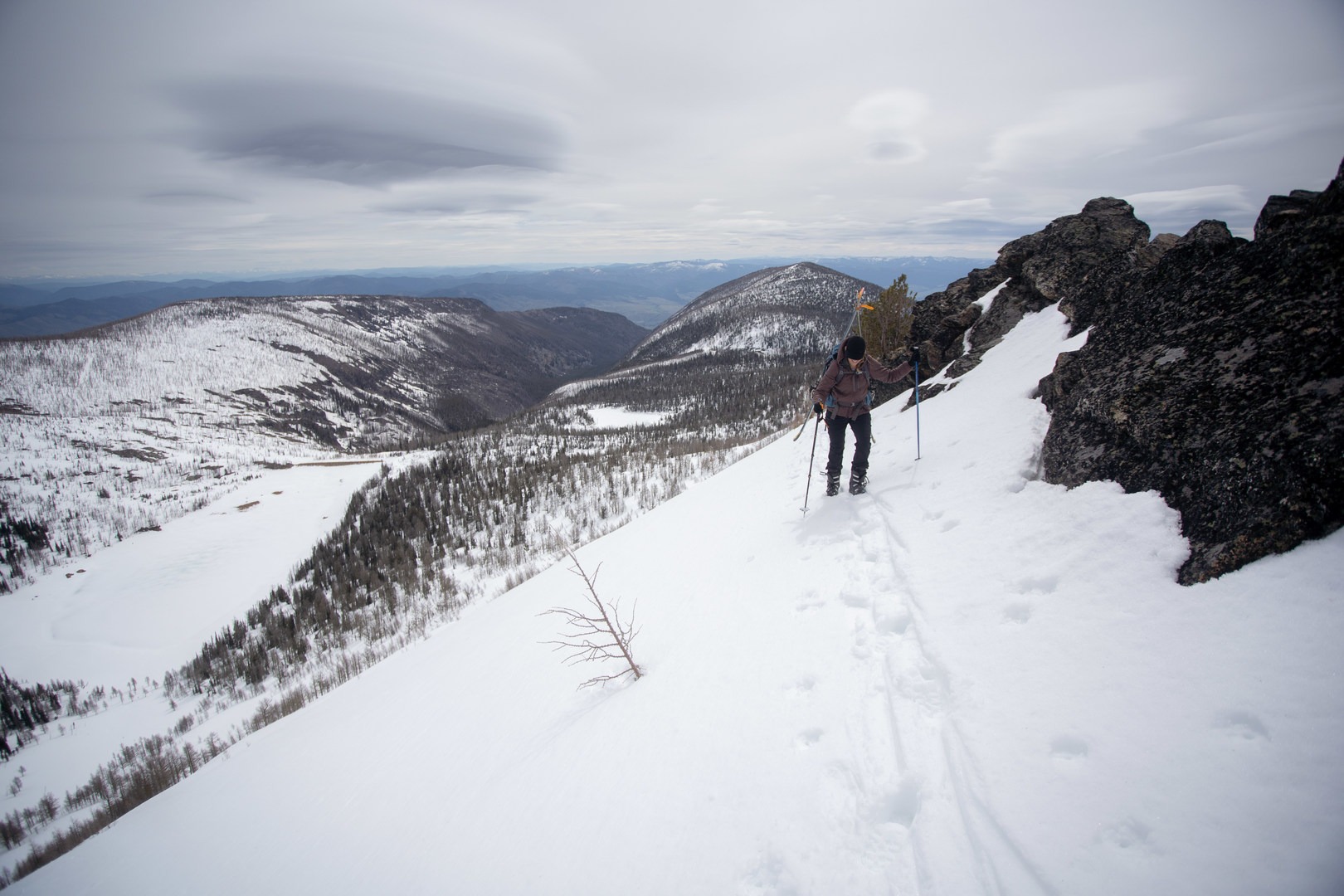You are here
Lolo Peak sits on the southern skyline of the Missoula basin and is visible from across the northern Bitterroot Range. But while the true summit is generally obscured from the valley floor, there's a lot of great skiing up there in all directions. It's a worthy objective for any Western Montana skier.
The Basics
-
Seasonality/Snow: Depending on the snowpack, Lolo can be skied from November to June, though as mentioned, whether Mormon Peak Road is open changes the equation dramatically.
-
Snow Stability: This tour travels through avalanche terrain so be sure to check Missoula Avalanche Center (our local avalanche center) before heading out. In addition, take the time to assess stability along your route - does your assessment line up with the forecast?
-
The Road: This route is generally accessed by Mormon Peak Road. When it's closed, from December 1st to May 15th, Lolo Peak can be climbed via Mill Creek (and a ton of gain). But when the road opens after May 15th, Lolo Peak is more accessible (though it's still a 5,000'+ day). This route will describe the standard Mormon Peak Road approach.
The Equipment
Depending on when you’re going and what the snow is like, you’ll need some equipment to keep having fun. There are the obvious ones, including your backcountry ski/splitboarding setup, personal safety gear (helmets, goggles, medkit, etc.), and appropriate layers to keep yourself warm and dry. And there’s the additional gear:
-
Avalanche safety gear: beacon, shovel, probe, and the know-how to use it!
-
Traction: You will probably want ski crampons and a Whippet/axe, and you may want crampons.
-
Approach Shoes: You'll probably need these.
-
Radios: Radios are becoming more and more common in the backcountry skiing world, as they dramatically improve communication and safety.
-
GPS/Navigation: It's a rite of passage for Missoula skiers to get lost in the burn zone on the way out, so it's worth your while to make sure you're bringing a GPS.
A disclaimer on this description and included GPX track - this line was skied on a single day with certain snow and avalanche conditions. The track described is a reasonable way to move through this terrain, and the description below mentions some of the hazards found during the trip. However, conditions may be significantly different when you visit this area. The advice in this trip report is not meant to be followed perfectly - you will need to adapt the route for the conditions you find and for your party’s abilities.
The Trip
The Approach
Begin at the trailhead, at a hairpin turn at 5,800' on Mormon Peak Road. Head up the summer trail through the burn zone and at some point you'll get to snowline. Get your skis on and start skinning south up the ridgeline, generally following the summer trail (cutting the switchbacks). At 8,200, you'll reach broad Carlton Ridge. Continue southwest toward the outflow of Carlton Lake, which will come into view soon. Rip skins and enjoy the low angle skin down to the lake.
From the lake outflow, head southwest to gap in the ridgeline at 8,500'. From here, head up the ridgeline. It gets steep. Stay on the east side of the ridgeline, heading toward the false northern summit. If it's icy, you'll want crampons and an ice axe here. Continue to the false summit at 9,096'.
The Skiing
From up here, you've got a lot of options.
- If you're a peakbagger, you can west traverse along the broad ridge to the true summit of Lolo. You might want to drop your skis unless you're trying to ski one of the northern lines (or down to North One Horse Lake, assuming the cornices on Lolo aren't too big).
- You can ski couloirs to the north off the false summit toward the small tarn.
- You can ski down to North One Horse Lake and Reed Lake.
- You can lap the lines northeast of the false summit.
Whatever you choose, when you're ready to exit, ski back down to Carlton Lake.
The Exit
From Carlton Lake, things are pretty straightforward. Climb back up to Carlton Ridge, roughly following your entrance tracks. Once you're up there, as long as snowline is pretty low, you've got a fun low-angle schuss through the burnzone. Keep an eye on your descent, as many people get lost here. Follow the summer trail if you get turned around, and once you find snowline, transition back to shoes and walk back to the car!
Participate in your backcountry community!
Please consider submitting an observation to Missoula Avalanche after your trip, describing the travel conditions and snow stability you found! Submitting snow observations and writing trip reports on forums are great ways to contribute to the community and improve avalanche forecasts. It's also incredibly valuable to read the local observations and trip reports written by others, as they'll help keep you updated on what the mountains are doing on a day-to-day basis. This will help determine whether you have a fun time next time you get out!
Logistics + Planning
Current Weather: Powered by Dark Sky






























Comments
Sign In and share them.